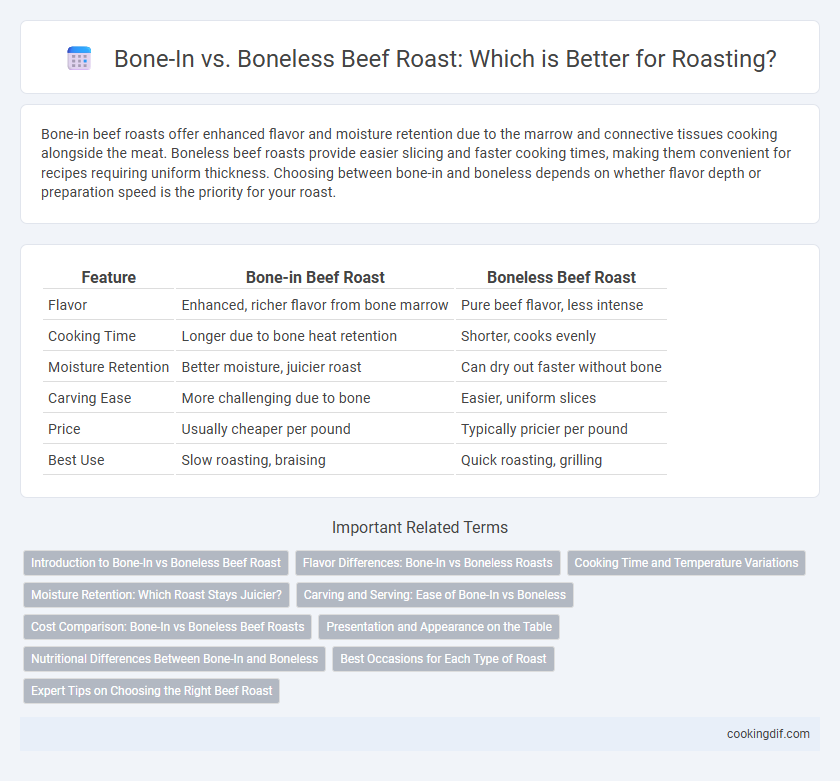Bone-in beef roasts offer enhanced flavor and moisture retention due to the marrow and connective tissues cooking alongside the meat. Boneless beef roasts provide easier slicing and faster cooking times, making them convenient for recipes requiring uniform thickness. Choosing between bone-in and boneless depends on whether flavor depth or preparation speed is the priority for your roast.
Table of Comparison
| Feature | Bone-in Beef Roast | Boneless Beef Roast |
|---|---|---|
| Flavor | Enhanced, richer flavor from bone marrow | Pure beef flavor, less intense |
| Cooking Time | Longer due to bone heat retention | Shorter, cooks evenly |
| Moisture Retention | Better moisture, juicier roast | Can dry out faster without bone |
| Carving Ease | More challenging due to bone | Easier, uniform slices |
| Price | Usually cheaper per pound | Typically pricier per pound |
| Best Use | Slow roasting, braising | Quick roasting, grilling |
Introduction to Bone-In vs Boneless Beef Roast
Bone-in beef roasts retain the rib or backbone, enhancing flavor and moisture during cooking by distributing heat evenly and preserving natural juices. Boneless beef roasts offer easier carving and faster cooking times, making them a convenient choice for meal preparation. Choosing between bone-in and boneless roasts depends on factors such as desired taste complexity, cooking method, and presentation preferences.
Flavor Differences: Bone-In vs Boneless Roasts
Bone-in beef roasts deliver richer, more intense flavors as the marrow and connective tissues slowly break down during cooking, infusing the meat with deeper savory notes. Boneless roasts offer a more uniform texture and quicker cooking time but may lack the complex, robust taste that bone-in cuts provide. The bone acts as a natural insulator, helping retain moisture and enhance juiciness, resulting in a more flavorful roast overall.
Cooking Time and Temperature Variations
Bone-in beef roasts retain heat longer, requiring slightly lower cooking temperatures and extended cooking times, typically around 15-20 minutes per pound at 325degF, to ensure even doneness and tenderness. Boneless roasts cook faster, with a general guideline of 12-15 minutes per pound at 350degF, allowing for quicker heat penetration and uniform cooking. Adjustments in cooking temperature and time are crucial to prevent overcooking boneless meat and undercooking the denser bone-in cut.
Moisture Retention: Which Roast Stays Juicier?
Bone-in beef roasts retain moisture better due to the bone acting as a natural insulator, which helps keep the meat juicier during cooking by reducing moisture loss. Boneless roasts tend to dry out faster since they lack the protective barrier of the bone, making precise temperature control and shorter cooking times essential for maintaining moisture. Research shows bone-in roasts consistently deliver more tender, succulent results, enhancing flavor and texture.
Carving and Serving: Ease of Bone-In vs Boneless
Bone-in beef roasts retain moisture and flavor, making carving more precise around the bone but slightly more challenging to slice uniformly. Boneless roasts offer ease of carving with consistent thickness slices and quicker serving, ideal for neat presentation. Choosing between bone-in and boneless depends on whether flavor complexity or convenience during carving and serving is prioritized.
Cost Comparison: Bone-In vs Boneless Beef Roasts
Bone-in beef roasts typically cost less per pound than boneless cuts due to lower processing requirements and higher demand for boneless options. The presence of the bone reduces usable meat weight, effectively increasing the cost if calculated solely by edible portions. Choosing bone-in can be more economical overall, but boneless roasts provide convenience and easier portioning, which may justify their higher price for some cooks.
Presentation and Appearance on the Table
Bone-in beef roasts offer a rustic and robust appearance, showcasing the bone as a natural centerpiece that enhances table presentation and adds visual appeal. Boneless roasts provide a clean, uniform shape that can be easier to carve and serve, giving a polished and refined look ideal for formal dining settings. The choice between bone-in and boneless impacts the overall aesthetic, with bone-in highlighting tradition and authenticity, while boneless emphasizes neatness and convenience.
Nutritional Differences Between Bone-In and Boneless
Bone-in beef roasts typically retain more minerals like calcium and phosphorus, which can leach from the bone during cooking, subtly enhancing the roast's nutrient profile. Boneless cuts often have slightly lower fat content, providing a leaner option with reduced calories and saturated fats. Both options offer high-quality protein, but bone-in roasts may contribute additional micronutrients beneficial for bone health and metabolic functions.
Best Occasions for Each Type of Roast
Bone-in beef roasts are ideal for slow-cooking occasions like holiday dinners or special family gatherings, as the bone adds flavor and moisture, enhancing tenderness and richness. Boneless beef roasts work best for quick roasting or slicing for sandwiches, making them suitable for weeknight meals or buffet-style events where ease of carving and presentation matter. Choosing between bone-in and boneless depends on the desired cooking method and the event's formality and time constraints.
Expert Tips on Choosing the Right Beef Roast
Selecting the ideal beef roast hinges on understanding the differences between bone-in and boneless cuts; bone-in roasts tend to retain moisture and flavor during cooking due to the marrow and connective tissues enriching the meat. Expert chefs recommend bone-in cuts like prime rib or beef chuck for slow roasting methods to maximize tenderness and taste, while boneless roasts provide ease of carving and uniform cooking, preferred for dishes like pot roast or oven-roasted brisket. Always consider cooking time, intended preparation style, and desired flavor intensity when choosing between bone-in and boneless beef roasts to achieve optimal results.
Bone-in vs Boneless for beef roast Infographic

 cookingdif.com
cookingdif.com